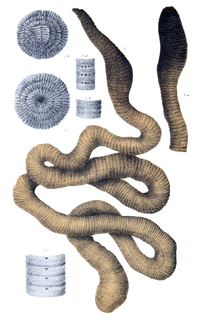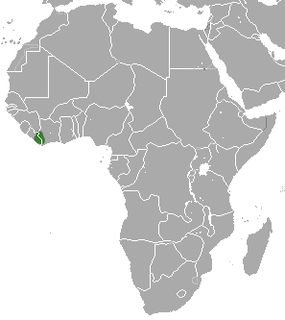
Moles are small mammals adapted to a subterranean lifestyle. They have cylindrical bodies, velvety fur, very small, inconspicuous eyes and ears, reduced hindlimbs, and short, powerful forelimbs with large paws adapted for digging.

Lumbricus terrestris is a large, reddish worm species thought to be native to Western Europe, now widely distributed around the world. In some areas where it is an introduced species, some people consider it to be a significant pest for out-competing native worms.

Pittas are a family, Pittidae, of passerine birds found in Asia, Australasia and Africa. There are thought to be 40 to 42 species of pittas, all similar in general appearance and habits. The pittas are Old World suboscines, and their closest relatives among other birds are in the genera Smithornis and Calyptomena. Initially placed in a single genus, as of 2009 they have been split into three genera: Pitta, Erythropitta and Hydrornis. Pittas are medium-sized by passerine standards, at 15 to 25 cm (5.9–9.8 in) in length, and stocky, with strong, longish legs and long feet. They have very short tails and stout, slightly decurved bills. Many have brightly coloured plumage.

The Lumbricidae are a family of earthworms. About 33 lumbricid species have become naturalized around the world, but the bulk of the species are in the Holarctic region: from Canada and the United States and throughout Eurasia to Japan. An enigmatic species in Tasmania is Eophila eti. Currently, 670 valid species and subspecies in about 42 genera are recognized. This family includes the majority of earthworm species well known to Europeans.

Oligochaeta is a subclass of animals in the phylum Annelida, which is made up of many types of aquatic and terrestrial worms, including all of the various earthworms. Specifically, oligochaetes comprise the terrestrial megadrile earthworms, and freshwater or semiterrestrial microdrile forms, including the tubificids, pot worms and ice worms (Enchytraeidae), blackworms (Lumbriculidae) and several interstitial marine worms.

The Megascolecidae is a taxonomic family of earthworms which is can be found native in Madagascar, in Australia, New Zealand and both South East Asia and North America. All species of Megascolecidae belong to the Clitellata class. Megascolecidae are a large family of earthworms and they can grow up to 2 meters in length. The intercontinental distribution of Megascolecidae helps in favouring the Continental Drift theory.

The giant Gippsland earthworm, Megascolides australis, is one of Australia's 1,000 native earthworm species.

The Glossoscolecidae are a large family of earthworms (annelids) which has native representatives in South and Central America. The species Pontoscolex corethrurus has a circumtropical distribution.

The giant Palouse earthworm or Washington giant earthworm is a species of earthworm belonging to the genus Driloleirus inhabiting the Palouse region of Eastern Washington and North Idaho, in the United States. The worm was discovered in 1897 by Frank Smith near Pullman, Washington. It can burrow to a depth of 15 feet (4.6 m).

The Liberian mongoose is a mongoose species native to Liberia and Ivory Coast. It is the only member of the genus Liberiictis. Phylogenetic analysis shows it is closely related to other small, social mongooses and that the banded mongoose is its closest relative.
Metastrongylosis is a parasitic disease that affects wild boars and pigs which live outdoors. It is caused by various species of roundworms of the genus Metastrongylus. A handful of cases of metastrongylosis have been reported in humans.

The Lake Pedder earthworm is an extinct earthworm species in the family Megascolecidae. Its genus Hypolimnus is monotypic.

An earthworm is a terrestrial invertebrate that belongs to the phylum Annelida. They exhibit a tube-within-a-tube body plan; they are externally segmented with corresponding internal segmentation; and they usually have setae on all segments. They occur worldwide where soil, water, and temperature allow.

The ashy robin, also known as the black-cheeked robin, is a species of bird in the family Petroicidae native to New Guinea.
Microchaetus rappi, the African giant earthworm, is a large earthworm in the Microchaetidae family, the largest of the segmented worms. It averages about 1.4 m (4.5 ft) in length, but can reach a length of as much as 6.7 m (22 ft) and can weigh over 1.5 kg (3.3 lb).
Earthworms are invasive species throughout the world. Of a total of about 6,000 species of earthworm, about 120 species are widely distributed around the globe. These are the peregrine or cosmopolitan earthworms. Some of these are invasive species in many regions.
Samuel James is an American scientist, a researcher specializing in evolutionary biology, focusing on earthworm taxonomy. James, with fellow researchers, has discovered numerous species of annelids, including Diplocardia californiana, Diplocardia woodi, Diplocardia montana, and a new species related to the Giant Palouse earthworm.
Octochaetus multiporus, commonly known as the New Zealand earthworm, is a megascolecid worm endemic to New Zealand. It is mainly found in the south of Manawatu but may also be found along the east coast of the South Island. A bioluminescent worm, Octochaetus multiporus secretes a luminescent fluid from its mouth when disturbed or punctured.
Octochaetus is a genus of earthworms of family Octochaetidae native to Australia, New Zealand, and Malaysia.










